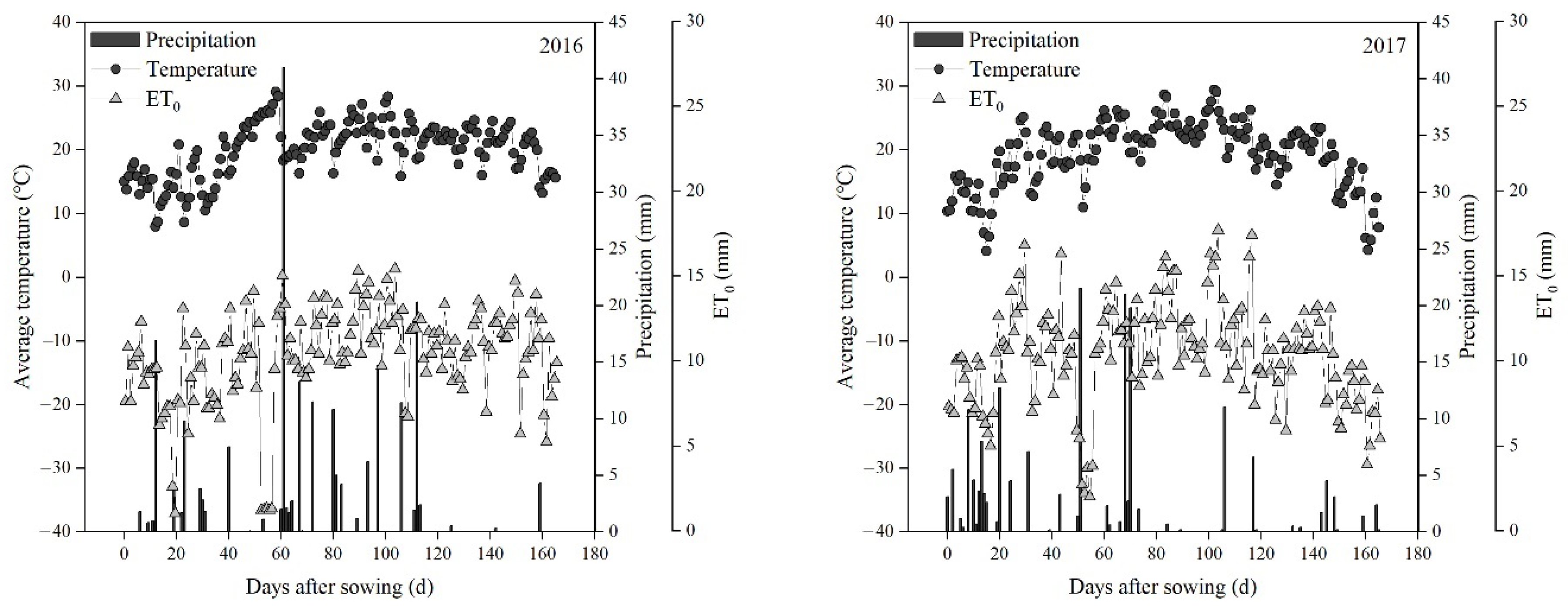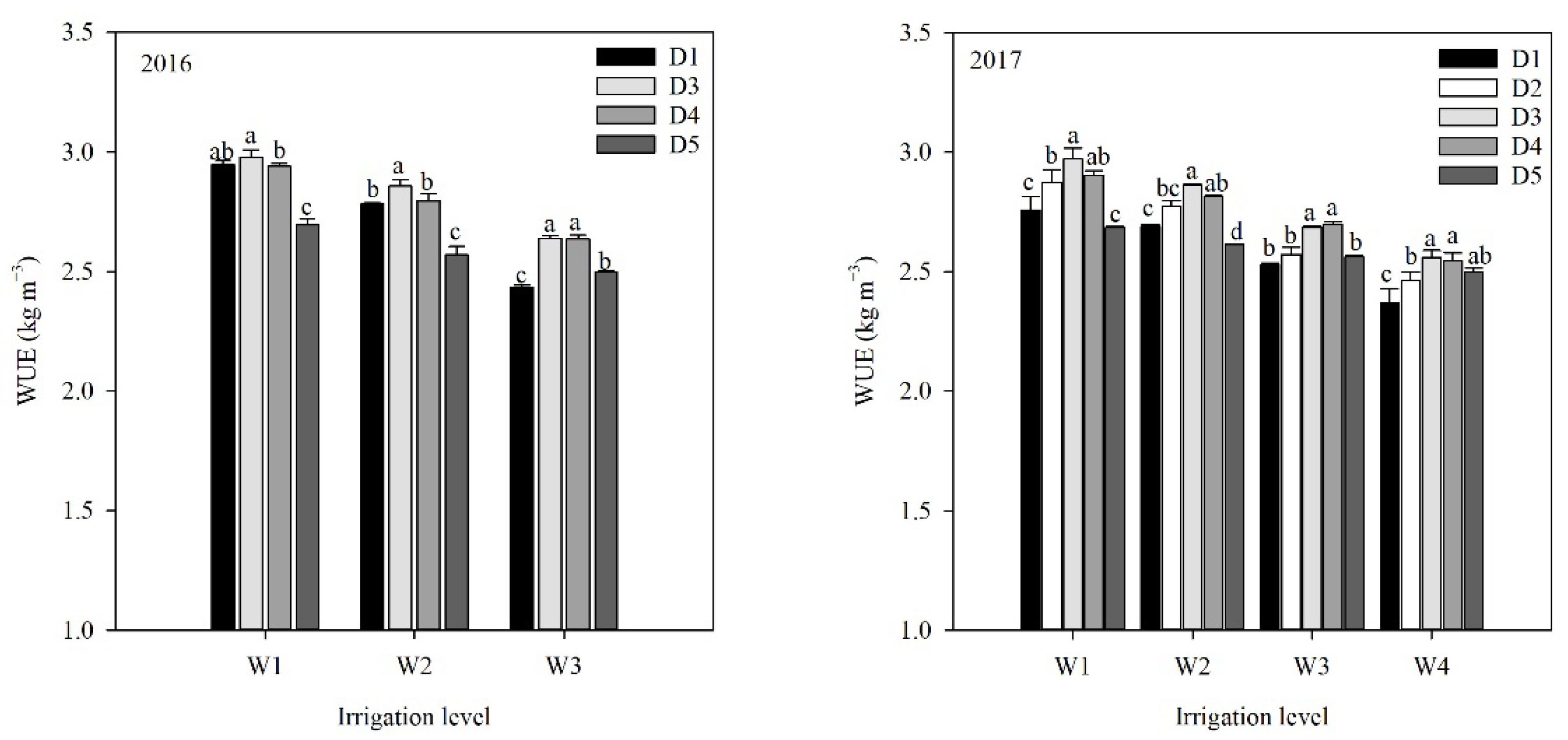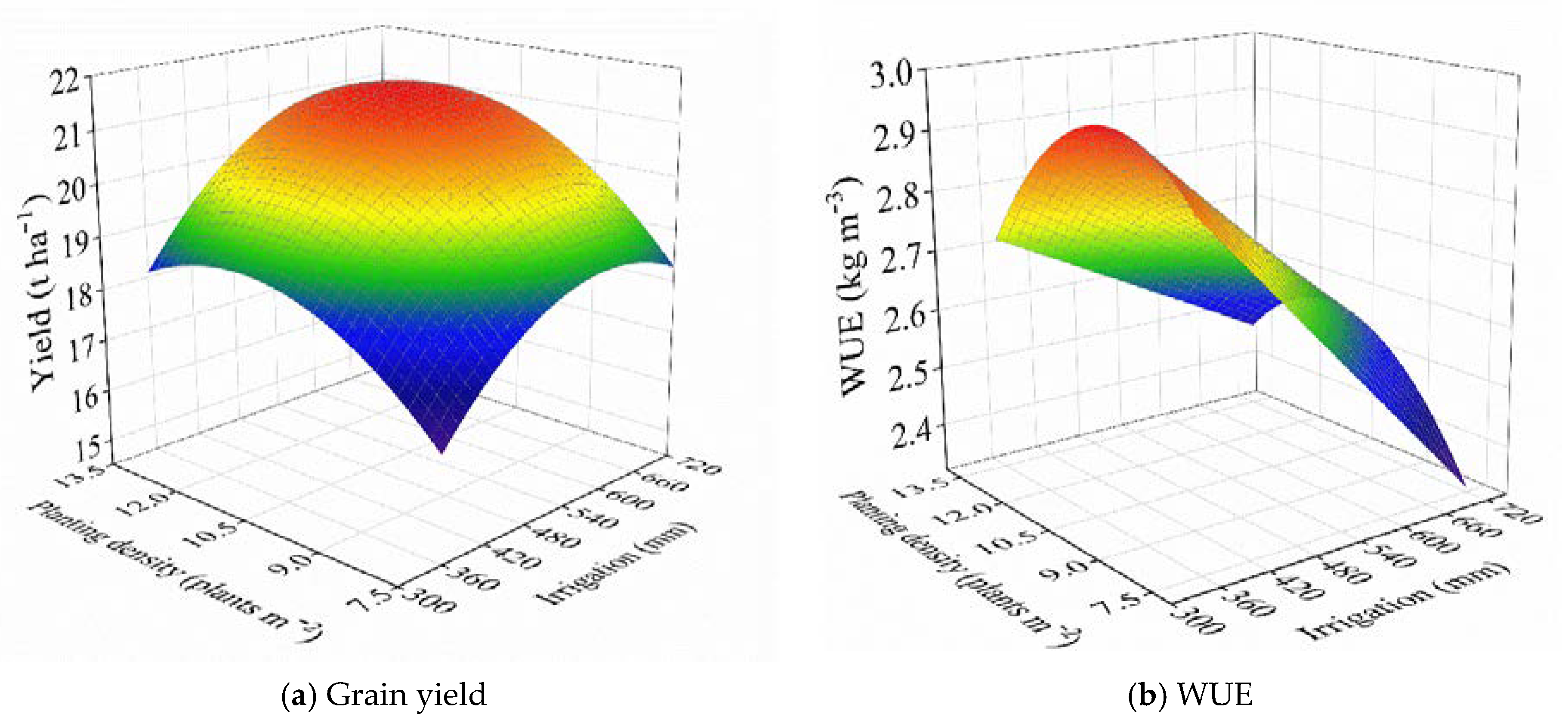Optimizing Planting Density to Increase Maize Yield and Water Use Efficiency and Economic Return in the Arid Region of Northwest China
Abstract
:1. Introduction
2. Materials and Methods
2.1. Experimental Region and Site
2.2. Experiment Design and Field Management
2.3. Sampling and Measurements
2.4. Statistical Analysis
3. Results
3.1. Grain Yield and Yield Components
3.2. Evapotranspiration
3.3. Water Use Efficiency
3.4. Economic Return
3.5. Evaluation of Optimized Irrigation and Planting Density
4. Discussion
4.1. Effect of Irrigation and Planting Density on Maize Yield
4.2. Effect of Irrigation and Planting Density on Evapotranspiration and Water Use Efficiency
4.3. Effect of Irrigation and Planting Density on Economic Return
Author Contributions
Funding
Institutional Review Board Statement
Informed Consent Statement
Data Availability Statement
Acknowledgments
Conflicts of Interest
References
- Tilman, D.; Balzer, C.; Hill, J.; Befort, B.L. Global food demand and the sustainable intensification of agriculture. Proc. Natl. Acad. Sci. USA 2011, 108, 20260–20264. [Google Scholar] [CrossRef] [PubMed]
- Cui, Z.L.; Zhang, H.Y.; Chen, X.P.; Zhang, C.C.; Ma, W.Q.; Huang, C.D.; Zhang, W.F.; Mi, G.H.; Miao, Y.X.; Li, X.L.; et al. Pursuing sustainable productivity with millions of smallholder farmers. Nature 2018, 555, 363–366. [Google Scholar] [CrossRef] [PubMed]
- Li, S.K.; Zhao, J.R.; Dong, S.T.; Zhao, M.; Li, C.H.; Cui, Y.H.; Liu, Y.H.; Gao, J.L.; Xue, J.Q.; Wang, L.C.; et al. Advances and Prospects of Maize Cultivation in China. Sci. Agric. Sin. 2017, 50, 1941–1959. [Google Scholar]
- FAO. The State of the World’s Land and Water Resources for Food and Agriculture; Food and Agriculture Organization of the United Nations: Rome, Italy, 2021; p. 22. [Google Scholar]
- Kang, S.Z.; Hao, X.M.; Du, T.S.; Tong, L.; Su, X.L.; Lu, H.N.; Li, X.L.; Huo, Z.L.; Li, S.E.; Ding, R.S. Improving agricultural water productivity to ensure food security in China under changing environment: From research to practice. Agric. Water Manag. 2017, 179, 5–17. [Google Scholar] [CrossRef]
- Zhang, G.Q.; Liu, C.W.; Xiao, C.H.; Xie, R.Z.; Ming, B.; Hou, P.; Liu, G.Z.; Xu, W.J.; Shen, D.P.; Wang, K.R.; et al. Optimizing water use efficiency and economic return of super high yield spring maize under drip irrigation and plastic mulching in arid areas of China. Field Crops Res. 2017, 211, 137–146. [Google Scholar] [CrossRef]
- Zhang, G.Q.; Ming, B.; Shen, D.P.; Xie, R.Z.; Hou, P.; Xue, J.; Wang, K.R.; Li, S.K. Optimizing Grain Yield and Water Use Efficiency Based on the Relationship between Leaf Area Index and Evapotranspiration. Agriculture 2021, 11, 313. [Google Scholar] [CrossRef]
- Zhang, G.Q.; Shen, D.P.; Ming, B.; Xie, R.Z.; Jin, X.L.; Liu, C.W.; Hou, P.; Xue, J.; Chen, J.L.; Zhang, W.X.; et al. Using irrigation intervals to optimize water-use efficiency and maize yield in Xinjiang, northwest China. Crop J. 2019, 7, 322–334. [Google Scholar] [CrossRef]
- Wang, F.; Xiao, J.F.; Ming, B.; Xie, R.Z.; Wang, K.R.; Hou, P.; Liu, G.Z.; Zhang, G.Q.; Chen, J.L.; Liu, W.M.; et al. Grain yields and evapotranspiration dynamics of drip-irrigated maize under high plant density across arid to semi-humid climates. Agric. Water Manag. 2021, 247, 106726. [Google Scholar] [CrossRef]
- Stepanovic, S.; Rudnick, D.; Kruger, G. Impact of maize hybrid selection on water productivity under deficit irrigation in semiarid western Nebraska. Agric. Water Manag. 2021, 244, 106610. [Google Scholar] [CrossRef]
- Irmak, S.; Djaman, K.; Rudnick, D.R. Effect of full and limited irrigation amount and frequency on subsurface drip–irrigated maize evapotranspiration, yield, water use efficiency and yield response factors. Irrig. Sci. 2016, 34, 271–286. [Google Scholar] [CrossRef]
- Sun, D.B.; Li, H.G.; Wang, E.L.; He, W.Q.; Hao, W.P.; Yan, C.R.; Li, Y.Z.; Mei, X.R.; Zhang, Y.Q.; Sun, Z.X.; et al. An overview of the use of plastic–film mulching in China to increase crop yield and water–use efficiency. Natl. Sci. Rev. 2020, 7, 1523–1526. [Google Scholar] [CrossRef]
- Zheng, J.; Fan, J.L.; Zhang, F.C.; Zhuang, Q.L. Evapotranspiration partitioning and water productivity of rainfed maize under contrasting mulching conditions in Northwest China. Agric. Water Manag. 2021, 243, 106473. [Google Scholar] [CrossRef]
- Yazar, A.; Howell, T.A.; Dusek, D.A.; Copeland, K.S. Evaluation of crop water stress index for LEPA irrigated corn. Irrig. Sci. 1999, 18, 171–180. [Google Scholar] [CrossRef]
- Zhai, C.; Zhou, H.P.; Zhao, J. Experimental Study on Inter-Annual Water Requirement and Water Consumption of Drip Irrigation Maize in North of Xinjiang. Sci. Agric. Sin. 2017, 50, 2769–2780. [Google Scholar]
- Assefa, Y.; Prasad, P.V.V.; Carter, P.; Hinds, M.; Bhalla, G.; Schon, R.; Jeschke, M.; Paszkiewicz, S.; Ciampitti, I.A. Yield responses to planting density for US modern corn hybrids: A synthesis-analysis. Crop Sci. 2016, 56, 2802. [Google Scholar] [CrossRef]
- Xu, W.J.; Liu, C.W.; Wang, K.R.; Xie, R.Z.; Ming, B.; Wang, Y.H.; Zhang, G.Q.; Liu, G.Z.; Zhao, R.L.; Fan, P.P.; et al. Adjusting maize plant density to different climatic conditions across a large longitudinal distance in China. Field Crops Res. 2017, 212, 126–134. [Google Scholar] [CrossRef]
- Li, J.; Xie, R.Z.; Wang, K.R.; Hou, P.; Ming, B.; Zhang, G.Q.; Liu, G.Z.; Wu, M.; Yang, Z.S.; Li, S.K. Response of canopy structure, light interception and grain yield to plant density in maize. J. Agric. Sci. 2018, 156, 785–794. [Google Scholar] [CrossRef]
- Zhang, G.Q.; Shen, D.P.; Xie, R.Z.; Ming, B.; Hou, P.; Xue, J.; Li, R.Z.; Chen, J.L.; Wang, K.R.; Li, S.K. Optimizing planting density to improve nitrogen use of super high—Yield maize. Agron. J. 2020, 112, 4147–4158. [Google Scholar] [CrossRef]
- Hou, P.; Liu, Y.E.; Liu, W.M.; Liu, G.Z.; Xie, R.Z.; Wang, K.R.; Ming, B.; Wang, Y.H.; Zhao, R.L.; Zhang, W.J.; et al. How to increase maize production without extra nitrogen input. Resour. Conserv. Recycl. 2020, 160, 104913. [Google Scholar] [CrossRef]
- Assefa, Y.; Carter, P.; Hinds, M.; Bhalla, G.; Schon, R.; Jeschke, M.; Paszkiewicz, S.; Smith, S.; Ciampitti, I.A. Analysis of longterm study indicates both agronomic optimal plant density and increase maize yield per plant contributed to Yield Gain. Sci. Rep. 2018, 8, 4937. [Google Scholar] [CrossRef]
- Zhang, Y.; Wang, R.; Wang, S.; Ning, F.; Wang, H.; Wen, P.; Li, A.; Dong, Z.; Xu, Z.; Zhang, Y.; et al. Effect of planting density on deep soil water and maize yield on the Loess Plateau of China. Agric. Water Manag. 2019, 223, 105655. [Google Scholar] [CrossRef]
- Wang, Q.M.; Fan, Z.L.; Zhao, Y.H.; Yin, W.; Chai, Q. Effect of Plant Density on Water Consumption Characteristics of Maize in Oasis Irrigation Area. Acta Agron. Sin. 2017, 43, 1347–1356. [Google Scholar] [CrossRef]
- Zhang, X.F.; Luo, C.L.; Mo, F.; Ren, H.X.; Mburu, D.; Kavagi, L.; Dai, R.Z.; Wesly, K.; Ren, A.T.; Nyende, A.B.; et al. Density-dependent maize (Zea mays L.) yield increase in trade-off in reproductive allocation and water use under ridge-furrow plastic-mulching. Field Crops Res. 2021, 264, 108102. [Google Scholar] [CrossRef]
- Allen, R.G.; Pereira, L.S.; Raes, D.; Smith, M. Crop Evapotranspiration-Guidelines for Computing Crop Water Requirements, Irrigation and Drain; Paper No. 56; FAO: Rome, Italy, 1998; p. 300. [Google Scholar]
- Cakir, R. Effect of water stress at different development stages on vegetative and reproductive growth of corn. Field Crops Res. 2004, 89, 1–16. [Google Scholar] [CrossRef]
- Bozkurt, S.; Yazar, A.; Mansurolu, G.S. Effects of different drip irrigation amounts on yield and some agronomic characteristics of raised bed planted corn. Afr. J. Agric. Res. 2011, 6, 5291–5300. [Google Scholar]
- Wang, F.; Xie, R.Z.; Ming, B.; Wang, K.R.; Hou, P.; Chen, J.L.; Liu, G.Z.; Zhang, G.Q.; Xue, J.; Li, S.K. Dry matter accumulation after silking and kernel weight are the key factors for increasing maize yield and water use efficiency. Agric. Water Manag. 2021, 254, 106938. [Google Scholar] [CrossRef]
- Li, J.; Xie, R.Z.; Wang, K.R.; Ming, B.; Guo, Y.Q.; Zhang, G.Q.; Li, S.K. Variations in Maize Dry Matter, Harvest Index, and Grain Yield with Plant Density. Agron. J. 2015, 107, 829–834. [Google Scholar] [CrossRef]
- Sangoi, L.; Gracietti, M.A.; Rampazzo, C.; Bianchetti, P. Response of Brazilian maize hybrids from different ears to changes in plant density. Field Crops Res. 2002, 79, 39–51. [Google Scholar] [CrossRef]
- Liu, H.J.; Wang, X.M.; Zhang, X.; Zhang, L.W.; Li, Y.; Huang, G.H. Evaluation on the responses of maize (Zea mays L.) growth, yield and water use efficiency to drip irrigation water under mulch condition in the Hetao irrigation District of China. Agric. Water Manag. 2017, 179, 144–157. [Google Scholar] [CrossRef]
- Liu, Z.D.; Xiao, J.F.; Yu, J.C.; Liu, Z.G.; Nan, J.Q. Effects of varieties and plant density on plant traits and water consumption characteristics of spring maize. Trans. Chin. Soc. Agric. Eng. 2012, 28, 125–131. [Google Scholar]
- Liu, G.Z.; Liu, W.M.; Hou, P.; Ming, B.; Yang, Y.S.; Guo, X.X.; Xie, R.Z.; Wang, K.R.; Li, S.K. Reducing maize yield gap by matching plant density and solar radiation. J. Integr. Agric. 2020, 19, 2–9. [Google Scholar] [CrossRef]
- Karam, F.; Breidy, J.; Stephan, C.; Rouphael, J. Evapotranspiration, yield and water use efficiency of drip irrigated corn in the Bekaa valley of Lebanon. Agric. Water Manag. 2003, 63, 125–137. [Google Scholar] [CrossRef]
- Zwart, S.J.; Bastiaanssen, W.G.M. Review of measured crop water productivity values for irrigated wheat, rice, cotton and maize. Agric. Water Mang. 2004, 69, 115–133. [Google Scholar] [CrossRef]
- Zhang, P.; Wei, T.; Cai, T.; Ali, S.; Han, Q.F.; Ren, X.L.; Jia, Z.K. Plastic-film mulching for enhanced water-use efficiency and economic returns from maize fields in semiarid China. Front. Plant Sci. 2017, 8, 512. [Google Scholar] [CrossRef] [Green Version]




| Year | Irrigation Level | Plant Density | Harvested Ear (Plants m−2) | Kernel No. per Ear | 1000-Kernel Weight (g) | Grain Yield (t ha−1) |
|---|---|---|---|---|---|---|
| 2016 | W1 | D1 | 7.6 d | 571.4 a | 360.0 a | 16.4 d |
| D3 | 10.1 c | 465.4 b | 348.7 b | 18.7 a | ||
| D4 | 11.6 b | 451.3 b | 335.9 c | 18.4 b | ||
| D5 | 13.1 a | 390.6 c | 327.6 d | 17.7 c | ||
| W2 | D1 | 7.5 d | 621.8 a | 368.9 a | 18.3 c | |
| D3 | 10.1 c | 510.6 b | 353.4 b | 20.6 a | ||
| D4 | 11.6 b | 493.7 b | 343.3 c | 20.5 a | ||
| D5 | 13.1 a | 475.2 b | 335.8 d | 20.0 b | ||
| W3 | D1 | 7.6 d | 672.4 a | 370.1 a | 18.4 c | |
| D3 | 10.2 c | 547.6 b | 355.5 b | 20.7 b | ||
| D4 | 11.6 b | 527.9 b | 349.9 c | 21.0 a | ||
| D5 | 13.1 a | 504.0 b | 343.4 d | 20.5 b | ||
| 2017 | W1 | D1 | 7.5 e | 626.3 a | 421.5 a | 16.3 c |
| D2 | 8.8 d | 576.4 ab | 409.4 b | 17.6 b | ||
| D3 | 10.3 c | 554.5 b | 403.4 b | 18.6 a | ||
| D4 | 11.6 b | 452.9 c | 386.5 c | 18.9 a | ||
| D5 | 13.2 a | 406.6 c | 384.2 c | 17.8 b | ||
| W2 | D1 | 7.5 e | 665.0 a | 444.0 a | 18.6 c | |
| D2 | 8.9 d | 612.5 ab | 423.7 b | 19.3 b | ||
| D3 | 10.3 c | 575.5 b | 416.8 b | 20.8 a | ||
| D4 | 11.6 b | 491.5 c | 399.5 c | 20.7 a | ||
| D5 | 13.2 a | 483.1 c | 392.5 d | 20.4 a | ||
| W3 | D1 | 7.5 e | 675.3 a | 446.3 a | 18.7 c | |
| D2 | 8.9 d | 644.3 ab | 422.5 b | 19.5 b | ||
| D3 | 10.3 c | 596.4 b | 412.8 c | 20.8 a | ||
| D4 | 11.6 b | 525.5 c | 412.4 c | 21.2 a | ||
| D5 | 13.2 a | 505.4 c | 406.3 c | 20.7 a | ||
| W4 | D1 | 7.5 e | 666.0 a | 438.5 a | 18.6 c | |
| D2 | 8.8 d | 639.5 ab | 421.3 b | 19.6 b | ||
| D3 | 10.3 c | 590.5 b | 410.1 c | 20.8 a | ||
| D4 | 11.6 b | 522.9 c | 411.5 c | 21.0 a | ||
| D5 | 13.2 a | 519.8 c | 401.1 d | 20.8 a |
| Source of Variation | Harvested Ear | Kernel No. per Ear | 1000-Kernel Weight | Grain Yield |
|---|---|---|---|---|
| 2016 | ||||
| Irrigation (W) | ns | ** | ** | ** |
| Planting density (D) | ** | ** | ** | ** |
| D × W | ns | ns | ** | ** |
| 2017 | ||||
| W | ns | ** | ** | ** |
| D | ** | ** | ** | ** |
| D × W | ns | ns | ** | * |
| Y | ** | ** | ** | ** |
| Y × W | ns | ns | ** | ns |
| Y × D | * | ** | ** | ns |
| Y × W × D | ns | ns | * | * |
| Irrigation | Density | Seed Cost (USD ha−1) | Water Cost (USD ha−1) | Total Cost (USD ha−1) | Total Income (USD ha−1) | Economic Return (USD ha−1) |
|---|---|---|---|---|---|---|
| W1 | D1 | 127.8 | 255.6 | 1810.9 | 3942.6 | 2131.7 |
| D2 | 153.4 | 255.6 | 1836.5 | 4246.3 | 2409.8 | |
| D3 | 178.9 | 255.6 | 1862.0 | 4502.1 | 2640.1 | |
| D4 | 204.5 | 255.6 | 1887.6 | 4497.1 | 2609.5 | |
| D5 | 230.0 | 255.6 | 1913.2 | 4288.2 | 2375.0 | |
| W2 | D1 | 127.8 | 340.8 | 1896.1 | 4454.3 | 2558.1 |
| D2 | 153.4 | 340.8 | 1921.7 | 4650.1 | 2728.4 | |
| D3 | 178.9 | 340.8 | 1947.2 | 4990.3 | 3043.0 | |
| D4 | 204.5 | 340.8 | 1972.8 | 4975.0 | 3002.2 | |
| D5 | 230.0 | 340.8 | 1998.4 | 4869.4 | 2871.0 | |
| W3 | D1 | 127.8 | 426.0 | 1981.3 | 4470.3 | 2489.0 |
| D2 | 153.4 | 426.0 | 2006.9 | 4698.4 | 2691.5 | |
| D3 | 178.9 | 426.0 | 2032.4 | 5006.9 | 2974.5 | |
| D4 | 204.5 | 426.0 | 2058.0 | 5094.0 | 3036.0 | |
| D5 | 230.0 | 426.0 | 2083.6 | 4968.5 | 2885.0 | |
| W4 | D1 | 127.8 | 511.2 | 2066.5 | 4487.6 | 2421.1 |
| D2 | 153.4 | 511.2 | 2092.1 | 4732.1 | 2640.0 | |
| D3 | 178.9 | 511.2 | 2117.6 | 5028.7 | 2911.1 | |
| D4 | 204.5 | 511.2 | 2143.2 | 5064.5 | 2921.3 | |
| D5 | 230.0 | 511.2 | 2168.8 | 5011.8 | 2843.1 |
| Response Variable | Regression Equation | R2 |
|---|---|---|
| Grain yield (t ha−1) | ZYield = −3.437 × 10−5x2 − 0.1302y2 + 0.03929x + 2.869y + 3.667 × 10−4xy − 8.344 | 0.961 ** |
| WUE (kg m−3) | ZWUE = 1.389 × 10−7x2 − 0.01976y2 − 0.002751x − 0.336y + 1.417 × 10−4xy + 2.061 | 0.964 ** |
Publisher’s Note: MDPI stays neutral with regard to jurisdictional claims in published maps and institutional affiliations. |
© 2022 by the authors. Licensee MDPI, Basel, Switzerland. This article is an open access article distributed under the terms and conditions of the Creative Commons Attribution (CC BY) license (https://creativecommons.org/licenses/by/4.0/).
Share and Cite
Zhang, G.; Shen, D.; Ming, B.; Xie, R.; Hou, P.; Xue, J.; Wang, K.; Li, S. Optimizing Planting Density to Increase Maize Yield and Water Use Efficiency and Economic Return in the Arid Region of Northwest China. Agriculture 2022, 12, 1322. https://doi.org/10.3390/agriculture12091322
Zhang G, Shen D, Ming B, Xie R, Hou P, Xue J, Wang K, Li S. Optimizing Planting Density to Increase Maize Yield and Water Use Efficiency and Economic Return in the Arid Region of Northwest China. Agriculture. 2022; 12(9):1322. https://doi.org/10.3390/agriculture12091322
Chicago/Turabian StyleZhang, Guoqiang, Dongping Shen, Bo Ming, Ruizhi Xie, Peng Hou, Jun Xue, Keru Wang, and Shaokun Li. 2022. "Optimizing Planting Density to Increase Maize Yield and Water Use Efficiency and Economic Return in the Arid Region of Northwest China" Agriculture 12, no. 9: 1322. https://doi.org/10.3390/agriculture12091322
APA StyleZhang, G., Shen, D., Ming, B., Xie, R., Hou, P., Xue, J., Wang, K., & Li, S. (2022). Optimizing Planting Density to Increase Maize Yield and Water Use Efficiency and Economic Return in the Arid Region of Northwest China. Agriculture, 12(9), 1322. https://doi.org/10.3390/agriculture12091322











